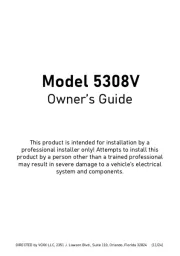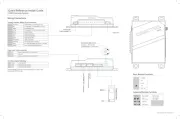Gemini 7673 Handleiding
Gemini
Auto alarm
7673
Bekijk gratis de handleiding van Gemini 7673 (5 pagina’s), behorend tot de categorie Auto alarm. Deze gids werd als nuttig beoordeeld door 91 mensen en kreeg gemiddeld 4.0 sterren uit 46 reviews. Heb je een vraag over Gemini 7673 of wil je andere gebruikers van dit product iets vragen? Stel een vraag
Pagina 1/5

Tensione nominale
Range tensione di alimentazione abilitato
Assorbimento massimo di corrente
P blocco motore
Portata contatto indicatori di direzione
ortata contatti relè
Durata di un ciclo d’allarme
Corrente massima positivo ad allarme inserito (+A)
Corrente massima comando comfort Positivo
Corrente massima comando comfort Negativo
12 Vdc
10,5
10mA
8A a 20°C
30 sec.
¸15Vdc
8A a 20°C
700 mA
500 mA
500 mA
CARATTERISTICHE TECNICHE
by GEMINI Technologies S.p.A.
Via Luigi Galvani 12 - 21020 Bodio Lomnago (VA) - Italia
Tel. +39 0332 943211 - Fax +39 0332 948080
Web site: www.gemini-alarm.com - e-mail: info@gemini-alarm.com AC 2626 Rev. 01-10/04
7673
MANUALE UTENTE
END USER’S MANUAL
For all EU Countries
No forest has been destroyed to
produce this 100% recycled paper.

ALARM SYSTEM DESCRIPTION
Dear Customer, we recommend to read both carely this manual and entirely,
so that ypu can acquaint yourself with and get the best operation results with
the system and the functions.
Functions programming is easy and you can change the programmation
anytime.
Below are described the alarm module fuctions:
!System arming and disarming by the automatic identifier “TAG” (art.7708).
!Anti-hijacking function (programmable).
!Acoustic signalling (excludible by programming from arming/ disarming).
!Optictic signalling (excludible by programming from arming/disarming).
!Perimetric protection.
!Volumetric protection (excludible by arming).
!Electrical engine immobilizer.
!Memoy Led.
!Electronic key for programming function, emergency unlock and total
disarming of the alarm system.
OPERATING DESCRIPTION
COMPLETE ALARM ARMING
!Stop the vehicle engine by turning the ignition key to “OFF” position.
!Open the vehicle door, leave the cabin, close the door and press the lock
button of the original radio control.
!Go away from the vehicle, bringing with you the TAG card.
!Not receiving the identifying code of the TAG card, the 7673 module will
arm the alarm system, 8 seconds after the last reception.
!Arming will be indicated by a turn signals flashing and an acoustic signal.
!If the door is reopened within 8 seconds after closing, arming will be
inhibited (the led will be constantly turned on) and normal procedure will
restart after the door closing.
SYSTEM ARMED
When the alarm does not receive any more the TAG card code, the system is
“armed”, that is to say it is ready to detect eventual theft attempts.
This situation is indicated by intermittent flashing of the LED.
ALARM ARMING WITH SENSOR EXCLUSION
This function allows the user to arm the system, with volumetric protection
(ultrasonic or over frequency, according to the choice) being excluded.
To de-activate this function, the system must be disarmed and the ignition key
turned to “OFF”; then proceed as follows:
!Open the driver side door of the vehicle and keep it open.
!During the whole time the door is open, the Led will be constantly turned on
and the alarm will be not armed, since the presence or not of the TAG is
ignored.
!Insert the electronic key in the specific receptcle.
!Exclusion of volumetric sensors will be indicated by two short
simultaneous flashings of turn signals and LED
!Close the door, press the lock button of the original radio control and go
away from the vehicle.
!Since the alarm is not receiving any more the TAG card code, it will be
armed only with the perimetric protections
NOTE: sensor cutout is limited to a single alarm activation cycle.
ALARM AND ALARM CYCLES
Any occured attempt will be indicated by the alarm with visual/acoustic
signalling (turn signal flashing and siren).
For every input and every arming cycle, the alarm causes are limited to five
cycles of 30 seconds each. The only alarm causes having no limits, are starting
attempt (positive under key +15/54) and wire cutting.
After the alarm cause has been restored, there is a “neutral time” of 5 seconds,
before a new signaling becomes possible.
ALARM DISARMING
Go close to the vehicle, so that the TAG can communicate again with the alarm.
Once the communication between TAG and alarm is restored, the system will
be disarmed; nevertheless the effective disarming will take place only when
the driver side door will be open. Disarming will be indicated by 3 flashings of
the turn signals and 3 acoustic signals.
NOTE : the system arming time depends on the TAG signal reception.
Since the code transmission has a timer control, TAG constrains the
disarming according to the signal reception by the alarm.
An alarm condition occurred, will be composed of five turn signal flashings and
five acoustic signals. Look relative paragraphs for possible causes and
signalling.
ALARM DISARMING WITH ELECTRONIC KEY (TOTAL DISARMING)
This kind of disarming has been conceived as an “EMERGENCY
RELEASING”; it should be used only when the TAG card does not function or
when vehicle maintenance is needed (in order to avoid possible continuous
arming/disarming).
Switch “OFF” the TAG card (when on function in order to vehicle manintenance
it is necessary to do this)
!Open and close the driver side door.
!Wait until the alarm system is armed (indicated by led blinking).
!Put the electronic key in the receptacle.
!The alarm system disarms (total disarming).
In order to restore normal operation, proceed as described in next pharagrap.
ARMING AFTER A TOTAL DISARMING
When the alarm is switch off with the electronic key, TOTAL DISARMING, the
alarm must be “wake up”.
PAG. 2 PAG. 3
UK

PAG. 4 PAG. 5
In order to restore the normal operation of the alarm system, proceed as
follows:
!Push the TAG button, until the LED is illuminated.
!Open and close the driver side door.
!Put twice the electronic key in the receptacle (alarm arming/disarming).
ALARM SIGNALLING DELAY
The system has a delay response of 15 seconds between the robbery
detection and its signaling (optical/acoustical signals).
This delay, or pre-alarm, has been programmed to avoid involuntary but
possible “false alarms” which can occur when the user opens the door or he
enters in the vehicle, while the system is still armed (no transmission by the
TAG card).
The pre-alarm condition will be indicated by the constant turning on of the led
and, if the system remains armed 8 seconds after the attempt, a loud acoustic
signal will be sent out. If the system has not been disarmed, within the pre-
alarm period, usual optical/acoustical signals will be activated.
NOTE: during the pre-alarm signaling, the alarm cycle and the neutral
time between two alarm signaling, just the reception of the TAG signal,
will disarm the system without any door being open.
ALARM MEMORY
When disarming the alarm, if five turn signal flashes and five beep signals
occur, it is possible to identify the cause generating the alarm condition.
To do this, turn the ignition key to “ON” and look at the vehicle status LED.
The LED will be blink, shown the last alarm condition.
The cause of the alarm will indicate for five times, and this indication can be
interrupted by turning the ignition key to “OFF” position.
The possible alarm signalling are indicated in the table below.
LED SIGNAL CAUSE OF THE ALARM
LED OFF (2 seconds) LED ON (400mS)
Absorption sensor
Positive under key (+15/54)
Trunk, hood volumetric sensors
External magnetic contact
Door switches
Cut wires
PROGRAMMING THE ALARM SYSTEM
Has been prevously programmed with standard configuration during
manufacturing procedure by Gemini.
The basic configuration can be modified in any moment and has the following
programmable functions:
KAcoustic signalling for arming and disarming (enabled).
LCurrent absorption sensor (disabled).
MAnti-hijacking function (disabled).
NOptictic signalling for arming and disarming (enabled).
Cutting off the power supply of vehicle electrical equipment, no programmed
functions are changed.
To modify the alarm programming, see at the indications repoted below:
!With the alarm system disarmed and the driver side door closed, turn the
ignition key in “ON” position.
!The LED will blink for a short time (about 1 second).
!During this period, insert the electronic key in the receptacle.
!Starting of programming procedure is indicated by one high tone and two
loud tones; if this does not occur, repeat the procedure from the beginning.
NOTE: this procedure must be carried out entirely. Indeed, by changing
the position of the vehicle ignition key, the function is confirmed, while
passing at the next one.
!In order to keep unchanged the operating state, turn the ignition key to
“OFF” and then back to “ON”. A loud acoustic signal will confirm the
operation.
!To change the operating state, put once the electronic key in the specific
receptacle.
!In both cases, the alarm will pass at the next function.
!Turn the ignition key to “OFF” (if not yet done, to keep unchanged the
operating state).
!The end of this procedure will be indicated by two acoustic signals, one
with loud tone and one with high tone.
Acoustics signalling
Current absorption sensor
Anto-hijacking function
Optical signalling
Vehicle ignition key - Confirm
Electronic key - Modify
Vehicle ignition key - Confirm
Electronic key - Modify
Vehicle ignition key - Confirm
Electronic key - Modify
Vehicle ignition key - Confirm
Electronic key - Modify
FUNCTION STATE
Product specificaties
| Merk: | Gemini |
| Categorie: | Auto alarm |
| Model: | 7673 |
Heb je hulp nodig?
Als je hulp nodig hebt met Gemini 7673 stel dan hieronder een vraag en andere gebruikers zullen je antwoorden
Handleiding Auto alarm Gemini

15 Januari 2023

13 Juni 2023

12 Juni 2023

9 Juni 2023

15 Januari 2023

15 Januari 2023

7 Juni 2023

15 Januari 2023

4 Juni 2023

3 Juni 2023
Handleiding Auto alarm
Nieuwste handleidingen voor Auto alarm

8 September 2025

27 April 2025

9 April 2025

31 Maart 2025

11 Maart 2025

30 Januari 2025

7 Februari 2024

7 Februari 2024

7 Februari 2024

6 September 2023